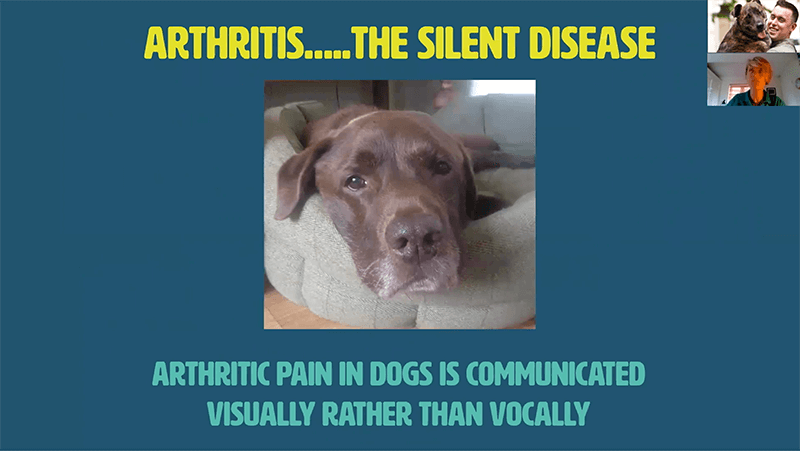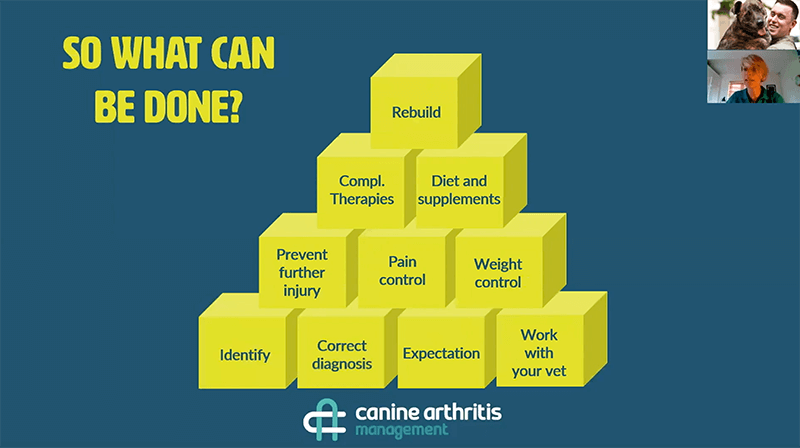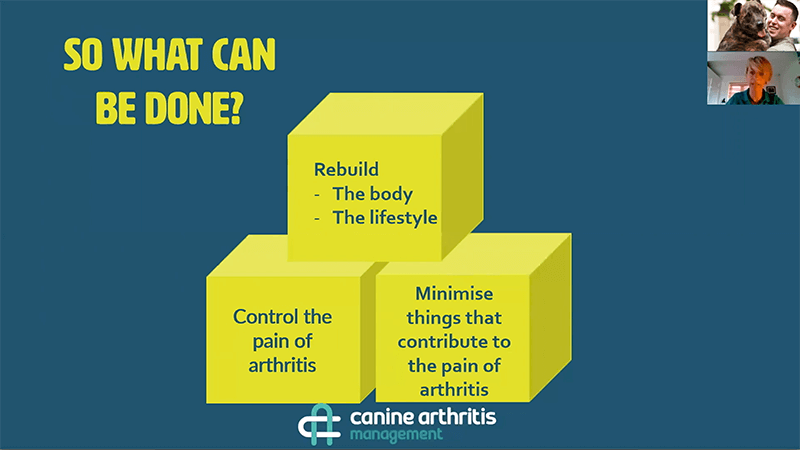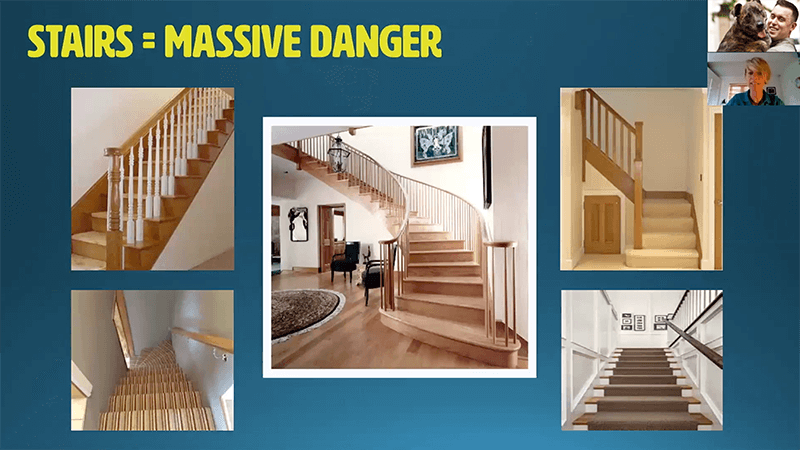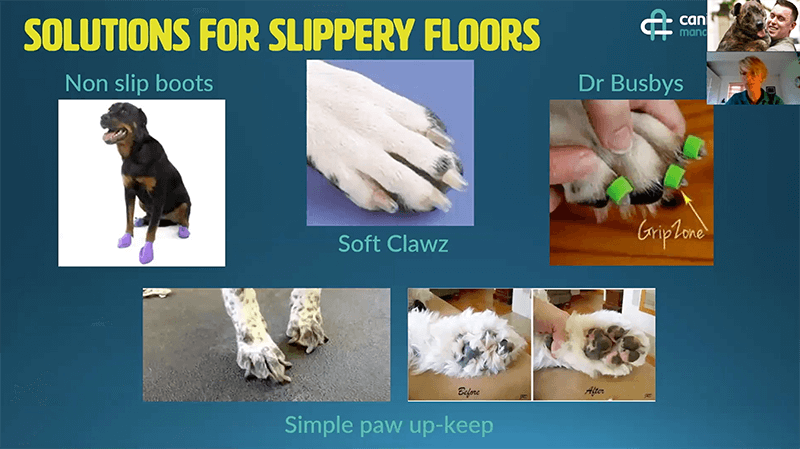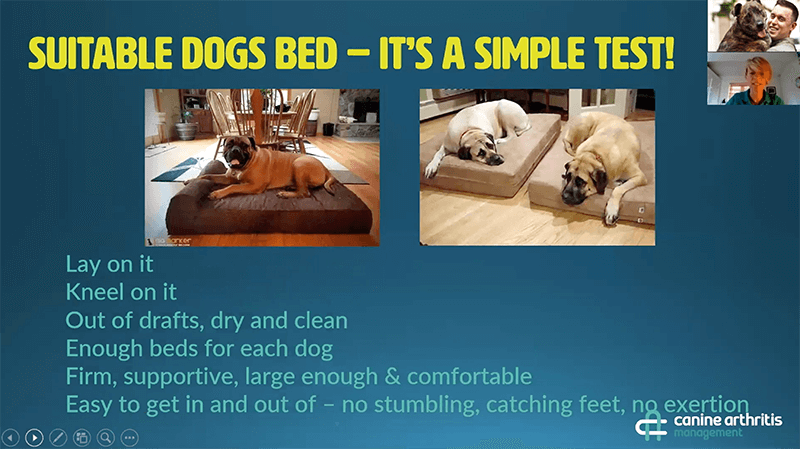Canine Arthritis Webinar
Arthritis... The Silent Disease
with Dr Hannah Capon and Big Barker
TRANSCRIPT
Eric Shannon: Hello, and welcome. My name is Eric Shannon. I'm the President of Big Barker Dog Beds, and I'm really glad you signed up to attend this event today. I know it's going to be well worth your time, because we're going to talk about what we believe to be is the number one health problem that our dogs face today.
My guest today is someone very special, Dr. Hannah Capon has over 16 years of experience as a small animal veterinarian, and she's the founder and Director of Canine Arthritis Management, which is an organization of veterinary professionals that's dedicated to educating dog owners about how to tackle the threat of arthritis to their dogs health, so they can help their dogs live longer, healthier lives, free from pain.
To us here at Big Barker, this really is the single most important health issue, because it dramatically reduces the quality of life for dogs as they age. The reason we make the Big Barker bed is to help keep dogs youthful for longer, and to bring older dogs back to their best. The number one problem that's preventing dogs from living their best lives as they age is canine arthritis. The Big Barker bed is our contribution to help remedy the effects, but there's several other pieces to the puzzle.
The reason we were so excited to meet Dr. Capon, is because she really is one of the voices in the veterinary world that's creating a big movement to educate both dog owners and veterinarians about the dangers of arthritis, and to help us understand that there really are things that we can do.
Dr. Capon does a better job than anyone I've ever seen educating dog owners about how to spot the subtle signs of arthritis, and point by point, sharing all the things we can do to help our dogs stay as healthy as possible.
Dr. Capon, thank you for joining us and sharing all your experience and wisdom with us today.
Dr. Hannah Capon: Thank you. Thank you very much, I'm really excited to be here. Hello from the UK. Let's get on with it.
Arthritis In Dogs, What's All The Fuss?
Let's crack on. I am a vet and I've been a vet for 16 years. I have tackled a number of things. I've done emergency medicine, small animal medicine, etc., but my passion really is chronic pain management. This is my lovely dog Holly, who has been a massive inspiration in me developing canine arthritis management.
Originally, it was just a team of two. About five years ago, I felt inspired to create the platform that we have now. As you can see, it was very much a one-sided event. We now are a huge team, and these are volunteers. They're veterinary nurses, vets, specialists, behavioralists, hydrotherapists, physiotherapists, life coaches, occupational therapists.
What this slide really demonstrates is arthritis is a big problem, and it spans many different disciplines in the veterinary world, from behavior to rehabilitation, orthopedics to internal medicine. We see a lot of it and it comes in lots of different presentations, and we'll get to that in a bit.
Why are we here? Because believe it or not, arthritis is the major reason that we put dogs to sleep. I'm just going to let that sink in for a moment, because people are generally surprised. Most people believe that animals are put to sleep because of heart disease, cancer, or that they just pass. I'm afraid it's not true. It's a major reason owners have to say goodbye to their dogs.
Let's just work out why this is happening. Arthritis is a painful condition. The main clinical sign of arthritis is pain. Without the pain, it's just a dysfunctional joint. It's just an animal that walks with a peg leg. It's the pain that's the problem. With the pain of arthritis, they choose to exercise less, to try and preserve themselves from experiencing pain. By exercising less, they lose muscle mass, their joints start to seize. Even if they had wanted to move, it becomes unbearable and they choose not to stand. It is when that they choose not to stand, is when owners say, "He's had enough. It's time to let go."
These are common phrases that get linked to this time, "Off back legs, can't get up, can't walk anymore, old age." What I want to illustrate is that we have all these lovely little terminologies for one big problem, which is musculoskeletal disease, and arthritis is the biggest in there.
How bad are the figures? 80% of dogs over the age of eight have arthritis. 80% of dogs that are over the age of eight that you know are suffering from arthritis. I love this slide. Who has dogs that match their sofa? It's amazing. I'm hoping I can really illustrate it is a massive problem in the older dog. I think these figures really illustrate that it's a massive part of a veterinarian's caseload, and also illustrates to an owner that it's very unlikely that you are going to avoid having arthritis develop in your dog. It's really unlikely. You're going to face it at some point.
Not Just A Disease Of The Older Dog
20% of all dogs, even dogs as young as one years old can have arthritis. I think that's when people really start to perk their ears up, because you really do link arthritis to be a disease of the old, degeneration, and I'm afraid it is not. Those young dogs that are limping, and they respond to an anti-inflammatory and rest, and then they start exercising again and the limp returns, there is something going on and that needs investigation. That could be early onset arthritis. By tackling it at a young age, you will get better results for a longer time, which really means your dog will have a better quality of life for a lot, lot longer.
It's also a disease that is more common in the larger dog. It's a disease that we see in the younger larger breed dog. We see it a lot in Rottweilers, German Shepherds, Labradors. Big breeds do tend to suffer from the disease more.
Let's go back to that horrible understanding that arthritis does kill. I was with this lovely gentleman Sean and his dog called Harold. It was when I said what I was doing and creating this online platform, he turned around and he looked me square in the face and he said, "What? Arthritis kills?" I was like, "I guess it does, yeah." I hadn't really thought of it like that. The reason that we do not take it seriously is that people do not die of arthritis. Arthritis is something that we know that we're more than likely going to suffer, but we know that we will manage it, because we're in control of our own condition and we're in control of our own pain.
It is not a terminal condition, but I'm sorry, it is with dogs. We find it very difficult to detect, observe, and manage their pain. We tend to detect it very late in the disease course, when already a lot of damage has been done. It's definitely a cause of euthanasia, but what's good is it's manageable. By us making a conscious effort to pick up on those subtle signs early, we can do so much more for it.
What Are The Signs?
What we have to remember is that dogs don't talk, well only in the movies. A lot of people say to me, "I wish he'd tell me. I wish he told me that he was in pain. If only they could speak," well, they do. They do speak, but they do it visually. What we need to be doing is looking out for the clues that they're giving us. We're going to run through some of them now.
Walking with an unusual gait. That means the dog that looks like it's drunk, or it keeps stumbling, or tripping, or it just doesn't seem to be coordinated. They have a jerky movement, they don't place their feet so well. Just to illustrate the point, I've got a beautiful dog, Holly. She's now nearly 16, and she's a Border Collie, and they're famed for their agility and fluid movement. They can tackle anything, rivers, to fences, very agile. Unfortunately, she's got a form of arthritis called lumbal sacral disease, and now she walks like a robot. That's sadly because she's suffering pain. I do my best to try and control it, but it's tough. She walks irregularly. She doesn't whine and she doesn't limp, she gets on with it.
Becoming withdrawn. They're in fear that they might get knocked and it might hurt. They've got throbbing, dull aches, and they just have to go and deal with it on their own. They just can't tolerate noise and intervention. Maybe they become a bit fearful, but they take themselves away, or the opposite. They become more needy. They become anxious, they cling to you.
When identifying the signs of chronic pain, what you're looking for is change. If you have a dog that was once very needy and loved social interaction, but they start taking themselves away, that's something to be worried about. If you've got a dog that was very independent, but now sticks to you like glue, that's something to be worried about and you need to speak to your vet.
Changes in the way that they position themselves. These are called transitions, if you want the technical term. Changing the way that you're going from a sit to a stand, a lay to a sit, the way they choose to lay, the way they actually choose to sit. If you look at this dog here, you can see that he's not sitting comfortably with his knees bent. A dog will sit in a position that they can shoot up into a stand and get going. He's not going to be able to do that with his foot out there, and that's because his knee is painful, but he doesn't whine. When he's up and walking, it's very hard to see, but the way he sat really screams, "My knee is painful."
Stumbling or losing balance. This picture, to me, is quite obvious, but it's a harder one for people to interpret. Look at the way that this dog's back legs are very close together. He hasn't chosen a very good position for his back legs. They've all gone all over the show, that's not a very stable way to walk. Look at his tail, it's counterbalancing, because he knows that he's wobbling and he's lost his balance. This dog's also got a very thick neck, and that's because these back legs are weak and the front legs have been compensating. They become very henched in the front, and a little bit piddly in the back.
Behavioral changes. This one really is a heartbreaker. They often change the way that they respond to certain behaviors. Fearful of pain, or because it actually is inducing pain. What we have to remember is that they can remember pain. If something that you did once before hurt them, they're going to prevent themselves being hurt again. They might grumble, they might show their teeth, they might have a fearful reaction.
The story, to illustrate this point, is a Jack Russell that I saw. He got named Mr. Grumpy when he was 10, because he just started being intolerant to the rest of the family. When he was 15, he went off his back legs, he couldn't walk. They rushed him to the surgery, and imaging was done, he had an MRI, and they found that a disc in his neck had been pushing against his spine, and it had just given, and really compressed his spine. The great news was they could surgically reduce it, but when the surgeon went in, he said that the damage that had been done meant that this dog had this prolapsed disc for years. Mr. Grumpy was not Mr. Grumpy, he was Mr. I'm In Pain.
Licking or chewing paws or joints. A lot of people relate this to skin rashes, insect bites, allergies, etc. A lot of dogs will lick an area that is offering the discomfort. This dog's wrists might be uncomfortable, but there's also referred pain to consider. The problem might be in a different region, and this dog is just getting the pins and needles, or you might even find that this is a coping strategy. If you think about it, if something is really grating on you, really throbbing, you do something to distract yourself away from it.
Changes in the way that they sleep. Now, my dog does this. There's a real curvature to the lower back, and they're bringing the back legs forward. My dog does it because her spinal nerves are being compressed. By laying like this, she relieves the compression on her spinal nerves, and it gives her a sense of ease. It takes away the pain for a period of time.
Changes in normal daily activities. I hope we can all see that this dog is hardly off on the floor. He's collapsed into a squat. He doesn't have strength in his back legs to position himself. He might have been a dog that used to cock his legs, and he can't do that anymore, he can't balance on one leg. He's chosen to use a squat, and even that's hard for him.
Often, a lot of these signs all lumped together with this terminology, "He's just slowing down." That's a bit worrying, because that's not a diagnosis. That's just an observation. It's an observation that there's something that needs to be looked at.
"She's just getting old." These phrases actually haunt me now. I hear them and I might [inaudible 00:15:24] "Let's go find it." If I don't find a problem and the dog is in its senior years, there's no reason to explain that behavioral change, then I might come close to accepting it and trying to improve that dog's quality of life the best I can.
Until I've checked, I don't feel that, that is an acceptable thing. We do not believe an animal's just getting old or just slowing down, without being sure that they are not in pain.
What Can Be Done?
Loads, loads. It's very exciting. This is the good bit. We can all put some smiles back on our faces. There is a structure to the way that we can start approaching this. First of all, we need to be identifying these. We're now aware that we've got a big problem, we've got 80% of dogs over the age of eight, 20% of dogs in total, they don't show it by limping, and yelping, and coming up and holding their paw. They do it in a variety of ways, from behavioral, to postural, to the way that their body shape changes. We need to be identifying these cases. Then we need to be going to the vet's and saying, "I believe that we have a problem brewing because of this, this, and this."
We need to be getting a correct diagnosis. Looking from afar and going, "I think he's got arthritis," is not good enough. There are so many different diseases that can present as slowing down. You can have kidney disease, you can have dementia, you can have cardiovascular disease or heart disease. There are many, many things that can cause that appearance of slowing down. We need to be making sure that we get a diagnosis. We want to prove that we haven't got [inaudible 00:17:11] disease, cardiovascular disease, endocrine disease, which is hormonal disease. Then we want to work out where is the pain coming from. Is it the hips? Is it the back? Is it the shoulders? Where is our pain emanating from? So that we can target our treatment.
We've got to have the right expectations. I'm just going to give you an example. My dog is 15, she has severe lumbosacral disease. She is on a variety of medications. I have resorted to stem cell therapy. I have tried a lot of things. I have now got to have the expectations that I'm running out of options. When you have arthritis diagnosed, it is not curative, unless you want to cut that joint out and put a joint replacement in, unfortunately it's not curative. It's about management. Expecting your vet to come up with a cure is not going to happen. Your vet's going to come up with solutions to slow the progression and to control the pain.
Work With Your Vet
It's not something you can do on your own. It's not something that the vet can do on their own. They need your input, and your support, and your observations, and your physical actions. Working with your vet is the best way to manage this disease. Most importantly, the underlying aim of all interventions when managing arthritis is pain control.
Pain control is absolutely imperative. It's ethical. It will mean that your dog will continue to move. They will continue to maintain their muscle mass. It will slow the progression of the disease process. It's essential for quality of life. It's essential for your quality of life. You don't want to see your animal in pain. Pain control is fundamentally important.
Weight control, weight has a huge influence on pain control, and progression of the disease. What a lot of people don't realize is, in the fat that your dog is carrying is inflammatory mediators. What does that mean? It means that fat is like petrol onto your arthritic fire. If you've got arthritis in your dog's knees and your dog is carrying five kilos too much, that is not only extra weight to carry, so that dog's weak back legs have to push, to get from a sit to a stand, but also that fat is making those knees more inflamed, and therefore more painful. By reducing your dog's weight, you will extend their life and their quality of life. It is proven. There is no argument against this.
Preventing further injury, and we're going to come back to this, because this is my [inaudible 00:20:08] I find it ridiculous that we spend a fortune on diagnostics, and anti-inflammatories, and further medications, and surgeries, and then we let our dogs skate around on laminate floors, and fall down the stairs, and trip over the decking. We'll come back to that.
Diet and supplements, they play a role. We still have a lot to learn. A lot of the supplements that are being advocated have not very much evidence behind them. We do know that omega 3 fatty acids play a huge role in controlling inflammation. We do know that weight control is hugely important in progression of the disease. We do know that there's a lot of supplements out there that have really positive effects, we just need to get some more info on them.
Complementary therapies. Now, this is a massive topic. This is everything from physiotherapy, to hydrotherapy, to massage therapy, to acupuncture. You name it, there's a lot out there. They all can play a role in managing pain and rebuilding muscular strength. They shouldn't be overlooked. We should not be drug reliant. We should be exploring all avenues for pain control and rebuilding physically.
Rebuild. This isn't just a physical rebuilding. An example would be a dog that's been suffering arthritis in their knee, you detect it, you realize there's been some muscle wasted. You get the pain relief on board, you get some exercise on board, you stop them doing the stairs and slipping on the floor. You do the physio and you start building your musculature there, that then supports the knee, so therefore the knee's less painful. Brilliant, you can come off your pain medication, but also rebuild your life with that dog and what your dog can do. Running and chasing balls isn't going to happen anymore. You've got arthritic knees, they can't cope. They get inflamed a day afterwards.
What Are You Going To Do Instead?
You're going to go and play hide and seek with the ball. You're going to go and scatter feed. You're going to do scenting, but you're not going to do high impact games. You're taking one behavior, one habit, one routine that you have and you're replacing it with something that's equally as fun for both you and the dog. Rebuild is about rethinking your life, both physically and mentally.
This is from Mr. Barker himself. It's a massive problem, it's a massive problem. Because humans are able to manage their own condition, we don't put so much emphasis on the importance of controlling arthritis, when we really, really should do.
I feel very, very strongly that our environment that we choose to keep our pets plays a massive role in controlling pain. Remember, pain control is absolutely fundamental to slowing the progression and reducing the clinical signs of arthritis. We're going to crack on that now, and this is all things that you guys can do free of charge, in your own home, as of tomorrow.
We're controlling the pain, we're working with our vets. We might be using medications. We might be using complementary therapies, but we're controlling the pain. It's absolutely fundamental. We're going to be looking at minimizing the things that contribute to the pain, the slippery floors, the stairs, the jumping out of the car, the chasing the ball. We know that we have to then think about rebuilding the body and rebuilding our lifestyle with that dog. We have years left together. We still want it to be enjoyable. We don't want it to be doom and gloom.
Environment
Now, this, to us UK, this central picture is the epitome of an American house. You have these massive staircases, according to all movies. Us lowly UK, we have these more cubby hole staircases down here, but they're all lethal, lethal. In my career, I'd like to say short, but it's true, 16 years, I've put a number of dogs to sleep that have fallen down the stairs. Arthritic dogs that have had a bad foot placement and they've tumbled. It's not just coming down the stairs. If you've got weak, painful back legs, can you imagine the torture of trying to get up those stairs? Look at the substrate that they're walking on. That is lethal.
Slippery wooden stairs, it's not lethal to you, because you probably wear rubber back shoes. You've got this non-slip, easy clean floor, so you don't need to take your shoes off, do you? You wouldn't go up and down those stairs with socks on. You wouldn't let your children do it. You need to be thinking outside the box. I just want to break it to you gently, dogs pads' are not like Spider-Man. They don't offer grip. By the age that they're starting to develop arthritis, that's become a keratinized smooth surface.
They're slippery. They are like high heels for women in a disco, not a good idea.
Your solutions, your get your stair gates, and you just say, "Sorry, it's not happening anymore." If you use harnesses to make sure that they go up supported, so they don't get the wobble on and they don't lose their balance. You've got to make sure that the stairs have grip on them, that they're well lit.
No grip floors, these are massive in the UK. I'm really looking forward to there potentially being a study in the next five to ten years, to prove that these have a massive influence on the development of arthritis, as well as the progression. They are dangerous. You see these video clips of dogs chasing balls, and they're falling over, and they're sliding, and everybody thinks it's really funny. I'm sorry, it's not funny. I'm really sorry. These are dogs that are injuring themselves, but they don't pipe up, because they're all heightened with adrenaline, and it's fun and exciting, and they didn't feel any pain, "Yeah, throw the ball again." When the ball's taken away and those chemicals in the brain calm down, that's painful. You wouldn't allow your grandma or your child to be running around and hitting the deck countless times. We shouldn't be doing it with the dogs.
The Solutions
Carpets, runners, rubber back mats. If you're keen, you can put down some anti-slip varnishes, or prevent access. There's lots of solutions for you to maintain your lovely laminate floors. I haven't had great success, I've looked at a lot of them. Dr. Busby's have got a big following, Soft Clawz, these non-slip boots for paws. I've struggled with most of them. I think actually the most logical thing is get some rugs down and get your eyes used to it. You can get used to seeing your rugs, you can't get used to losing your dog. Personally, I think they're lovely idea and I think they're suitable for situations you can't control, but I think you'll have much better results if you just accept that, that shiny floor has to be covered. Trim the feet as well. You can see down here, that's a logical conclusion. Try to expose those pads for as much grip as possible. There's some products out there, there are paw waxes and something called Paw Friction. Again, I still think that rugs are much, much better.
A lot of people let their dog sleep on the sofa or sleep on the bed. They're part of the family. When I started Canine Arthritis Management, I really felt that I needed to try and achieve perfection and tell them, "No, don't do it. You can't. These dogs are going to hurt themselves getting on and off." Then I realized that, that affects quality of life, because that dog's done it for 10, 13, 15 years. To suddenly tell them that they can't do something, is actually going to really mess their head up.
I feel that you need to look into solutions. You need to look into ways that you can make sure that they get on and off safely. Some dogs tolerate these really well. Some dogs grow accustomed to the steps and the ramps really quickly. Some dogs seem in fear of it. You've got to think outside the box.
I was looking after a lovely German Shepherd called Fletcher, and he wouldn't use the footstool to get onto the sofa, so the lady had a wooden box made the full length of the sofa, and she got a throw, and the throw went over the sofa and then over the box. It became a massive throne, and he could not avoid using this camouflage box to get onto the sofa. Much better. He stopped hurting himself every time he was getting on and off.
I'm afraid they do, do habit, even if it hurts. They will carry on doing something that they've done for years, even if it hurts.
Beds
We love beds. Now hopefully there's going to be some studies out in the next few years, looking at the influence of what seems quite an innocuous addition to your house. It's really important. At this present time, I can only really suggest that you empathize. If you had painful hip arthritis, you had a bad lower back because of it, and you just had pain that was emanating down your legs, etc., you would not sleep on a hard floor. You would invest in an expensive mattress, an orthopedic, a memory foam, something that would allow you to sleep comfortably, to allow your muscles to relax. So that your joints, your bones, they aren't laying on a cold, hard surface. It is obvious to us. We spend a fortune on it. Our hospitals have appropriate bedding to ensure quick recovery. We only need to extrapolate. Yes, I'm hoping that there's going to be some new studies out.
What we're looking for our beds that are firm and predictable. We don't want an unstable, slightly wobbly, painful dog to step on a bed and not know whether it's going to support them, because they'll be in fear of it and they won't use it. It's got to be firm. It's got to have predictable edges. It's got to be big enough for them to be able to stretch out on. We don't want loads of rugs on it, because we don't want their feet to get caught up. We want them to be safe, not hazardous. Simply, a bed that you'd want to get in.
Now, I'm really lucky. I myself have a Big Barker dog bed, and I will admit that I use it to watch TV. It is very comfortable.
Key things, lay on it, kneel on it. Is it out of drafts? Is it in a low traffic area of the house? Can they sleep there without being disturbed? They're not going to have their nose or their legs brushed past every time you're trying to get from the kitchen to the living room. Can they stay there undisturbed and actually relax? Do they get in and out of it comfortably? We don't want any stumbling and we don't want any catching of feet. It's got to be a bed that you would want to get in.
These are no go's in my books. I hate these plastic dog dishes. For me, they're just containing hair and dirt. It's making a human's life easier. I wouldn't say it's extremely exciting for a dog to nuzzle into. The one in the middle, that's just a disaster waiting to happen. If this dog already has difficulty getting up, that's just making it harder. Then I sped over here, we've got a trip hazard written all over it.


